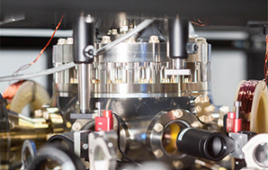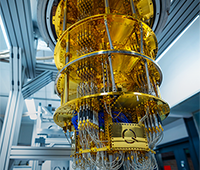Berkeley Lab to Develop World’s Fastest Computer Network
 |
| ESnet Department Head Steve Cotter (second from left), shown here with the ESnet team and a map of the high-performance computer network they manage, will oversee development of a prototype 100 Gbps network. |
As scientists in a wide variety of disciplines increasingly rely on supercomputers and collaboration with colleagues around the world to advance their research, managing and sharing the mountain of data generated by their investigations will soon become a choking point. In order to facilitate such data-intensive research, ESnet, the Department of Energy’s high-performance networking facility managed by the Lawrence Berkeley National Laboratory, is receiving $62 million to develop what will be the world’s fastest computer network, designed specifically to support science.
Funded by the American Recovery and Reinvestment Act, the Advanced Networking Initiative will ensure that the United States stays competitive in science and technology. Specifically, ESnet will develop a prototype 100 gigbits per second (Gbps) Ethernet network to connect DOE supercomputer centers at speeds 10 times faster than current technology.
“This network will serve as a pilot for a future network-wide deployment of 100 Gbps Ethernet in research and commercial networks and represents a major step toward DOE’s vision of a 1-terabit — 1,000 times faster than 1 gigabit — network interconnecting DOE Office of Science supercomputer centers” said Michael Strayer, head of DOE’s Office of Advanced Scientific Computing Research.
“ESnet has always been a service organization,” said Steve Cotter, ESnet Department Head at Berkeley Lab. “We exist to enable DOE scientists to do great work at the cutting edge, and to increase the scientific capabilities of the United States. The deployment of a next-generation 100 Gbps network will ensure that we continue to provide state-of-the-art services to our constituents and continue to enable scientific discovery.”
At a time when economic conditions are forcing private companies to cut back on investment in research and development, ESnet will be working with telecommunications companies and hardware vendors in bringing to market the latest networking technologies and deploying them in this pre-standards, prototype network.
As planned, some of the $62 million for this Initiative will be used to create new jobs for network and software engineers at Berkeley Lab, but the bulk of the funding will be used for purchasing networking equipment or services from service providers who have the infrastructure to support the new 100 Gbps technology. In all, up to $59 million will be invested directly in the telecommunications industry in the United States.
In addition to the direct economic benefits of the project, there are induced ones as well. Several studies have shown that network investments provide both immediate and long-term benefits, ranging from higher wages to driving productivity and economic growth. By developing 100 Gbps now, more universities and companies will find 10 Gbps and 1 Gbps networks far more affordable.
Science-driven need for more bandwidth
DOE scientists are now generating data at the terabyte scale, and datasets will soon be in the petabyte range, or 1,000 terabytes. Moving this much data will require both greater bandwidth and reliability, as well as new protocols to enable these high-speed transfers.
The study of global climate change is a critical research area, where the amount of data being created and accessed is growing exponentially. For example, an archive of past, present and future climate modeling data maintained by the Program for Climate Model Diagnosis and Intercomparison at Lawrence Livermore National Laboratory contains more than 35 terabytes of data and is accessed by more than 2,500 users worldwide. However, the next-generation archive is expected to contain at least 650 terabytes, and the larger distributed worldwide archive will be between 6 to 10 petabytes.
Another scientific driver for increased bandwidth is the Large Hadron Collider in Switzerland. Within this accelerator — the world’s largest — millions of protons racing at near the speed of light will collide every second; scientists suspect the outcome of these “subatomic smashups” will provide valuable insights into the origins of matter and dark energy in the Universe. The experiments will generate more data than the international scientific community has ever tried to manage — up to 100 gigabits per second, to be processed and analyzed by scientists around the globe.
Funded by the American Recovery and Reinvestment Act, the project also includes creation of a national-scale test bed available for use by the research community and industry.
National-scale test bed
As part of the Advanced Network Initiative’s approximately $59 million investment in new networking equipment and services, about $8 million to $9 million will go toward a national-scale network test bed for use by the research community and industry to test out new technologies, protocols and applications.
The test bed will consist of advanced network devices and components assembled to give network and middleware researchers the capabilities to prototype ESnet capabilities anticipated in the next decade. As host of the test bed, ESnet will develop strategies to move mature technologies from testing mode to production service.
About ESnet
ESnet, formally known as the Energy Sciences Network, is already one of the world’s most advanced research networks, with tools to allow scientists to reserve network capacity in advance and, thus, guaranteeing bandwidth and service at specified times. Its current network, ESnet4, received a 2009 Excellence.gov award for innovative use of technology from the Industry Advisory Council.
ESnet is primarily funded by DOE’s Office of Science, one of the nation’s largest supporters of scientific research. Managed and operated by the ESnet staff at Berkeley Lab, ESnet provides high-bandwidth network connections to more than 40 sites conducting DOE-funded research, including some 20 large-scale experimental facilities and large supercomputing centers used by thousands of DOE scientists generating massive amounts of data. One goal of the project is to provide a 100 Gbps link between DOE’s largest unclassified supercomputing centers in California, Illinois and Tennessee.



